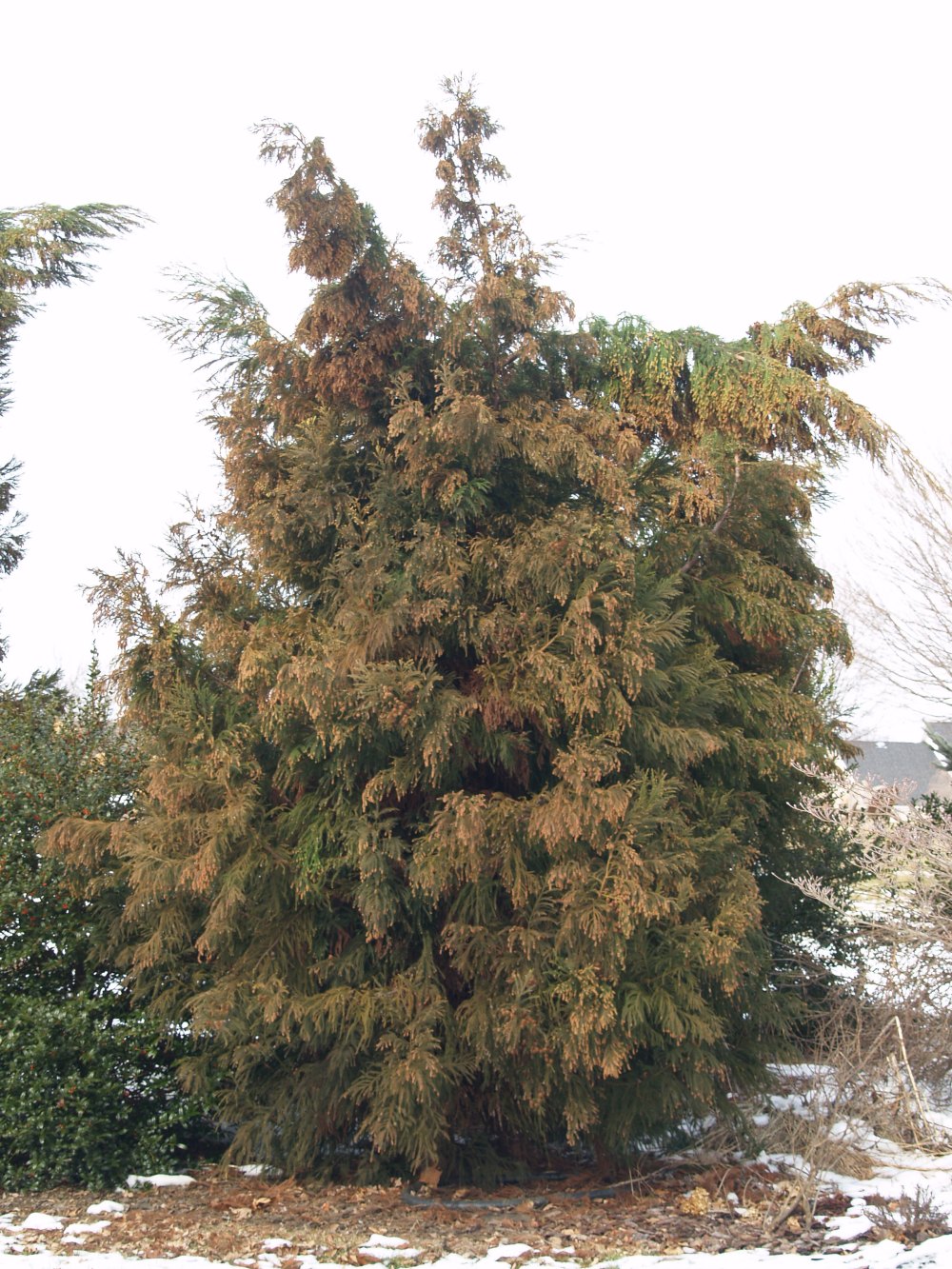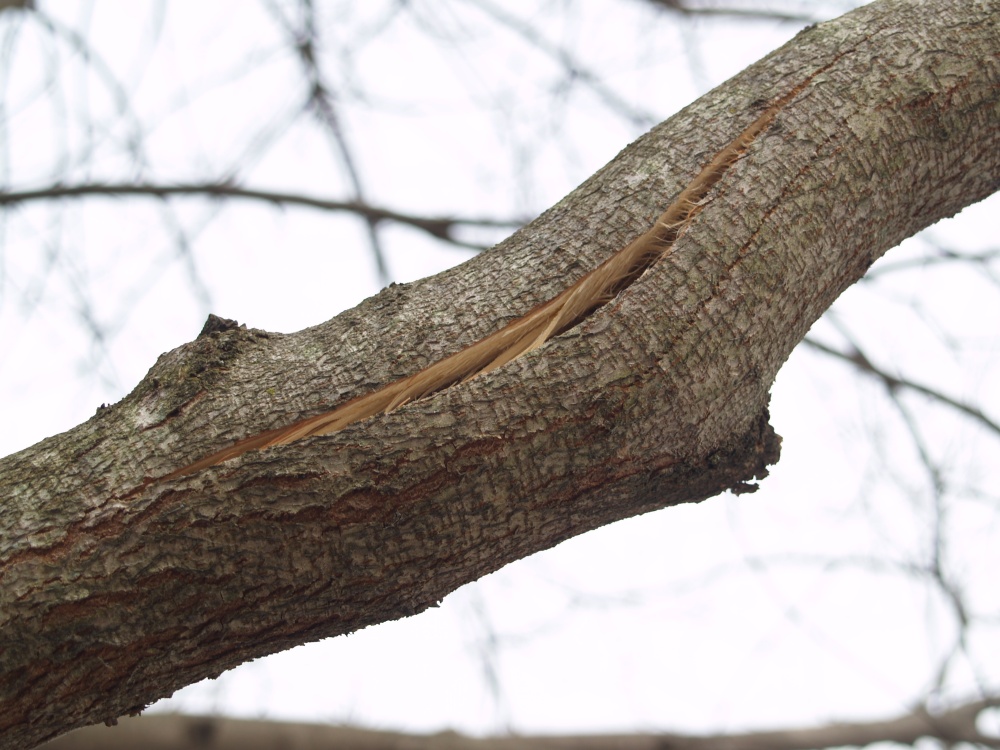As heavy, wet snow accumulated on the thickly branched red maple at the edge of my neighbor’s property, the Y-shaped junction where the tree forked into two trunks was severely stressed. Finally, the weight of snow was too great and half of the snow covered maple tumbled over, its fall broken only by a large dogwood just below the kitchen window. Fortunately, the tree was planted so that it did not fall into the house, but the following day it was apparent that the tree must be cut down.
The neighbor’s maple was victim to poor pruning practices many years earlier that allowed multiple trunks to develop, but often weaknesses in tree structure are recognized only after severe wind, ice, or snow events. My garden suffered substantial damage to deciduous trees and evergreens (a cryptomeria with a broken top, above), some a result of poor structure, but all due to the unusually wet snow. Today we’ll begin the process of sorting through the repairs, and deciding whether branches or entire trees can be salvaged.
First, please understand that working with chain saws can be extremely dangerous, in particular working on snowy ground or on ladders needed to cut branches beyond your reach from the ground. There is a time to realize that a project is beyond your capabilities, and if your safety is in doubt then the time is right to call for help.
Most of the repairs that I’ve accomplished on damaged trees in my garden today have been done with a folding pruning saw, a low cost tool with coarse teeth that cut easily through tree branches. A chain saw was used to cut large branches into sections, and hand pruners were used to clean up loose wood around the cuts.
In cutting away damaged branches I will try to minimize further damage to the tree, and attempt to preserve the branch collar, a raised ridge between a branch and an offshoot. Injuries will heal more completely, and more quickly, if the collar is maintained. Damage that requires removal of the branch collar will often suffer from rot since the tree will be slow to heal.
The first step in repairing the injury to this corkscrew willow (above) was to cut the long branch into pieces so that the weight did not cause further damage. Once the branch was cut with the chain saw so that a two foot stub remained, I used the pruning saw to begin a cut from the bottom (below), as flush to the branch collar as possible, so that the weight of branch did not further tear the bark as a cut was made from the top.
The cut was continued with the pruning saw from the top, so that the cuts met and the branch was removed (below). Excess loose wood and bark was removed with hand pruners, so that the cut is left smooth and the branch collar is preserved. This injury will heal in the coming year, and in a short time there will be no sign of the damage to the fast growing willow.
Repair to other injuries is not so obvious, or so simple. Redbuds are wide spreading trees with an arching branch structure that was particularly vulnerable to damage from the heavy snow. The ‘Silver Cloud’ redbud (below) branched only a few feet from the ground into three trunks, and one was split by the snow’s weight so that there was injury deep into the main trunk. 
I have removed the long branch, and made as clean a cut as possible (below), but the injury was deeper than the branch collar, so the long term survival of this tree will be in question. The wound will be left open to heal since tar-like tree dressings are of no value in preventing pests from entering, and can slow the pace of healing.
In some cases a partial break can be repaired by drilling a hole through the damaged sections and inserting a metal bolt to draw the injured parts together. In this instance the weight of the long branch was too great, but another partially split branch (below) will be repaired in this manner in a second chapter in another day or two. 
At that time we’ll also look at damage to an evergreen magnolia, and discuss injury to other evergreens and shrubs.
Thanks for all your advice on storm damage. I have three 60 year old eastern cedars that are each about 50 ft tall and had extensive damage last year fromthe snow here in DC. I had a pro come out and cut out all the damaged branches and thought I would do okay this year but again the heavy snow caused a lot of damage with the top snapping off one tree and as it fell down taking out many of the branches below. One of the trees now has extensive bare areas in the middle third of the tree. I am wondering whether it is likely to get any new growth in that zone or should I consider just having the tree removed? Thanks for your thoughts.
It is unlikely that the cedars will grow from the points where branches have broken. However, growth from other branches will slowly fill the void. How long will depend on the extent of the damage, but I would expect it to take years.
I have an eastern red bud that was damaged in ice snow storm. I didn’t want to just get rid of it, wondering could I save it. It was my favourite trees. I have a picture
I can send to you. I sent picture to a local aboraist. He said didn’t think could be saved. What should I do? Would greatly like another opinion. Thanks.
I’m happy to take a look. Send a photo to daver@meadowsfarms. When roots are pulled from the ground by wind or snow/ice it can be very difficult to straighten and secure the tree.